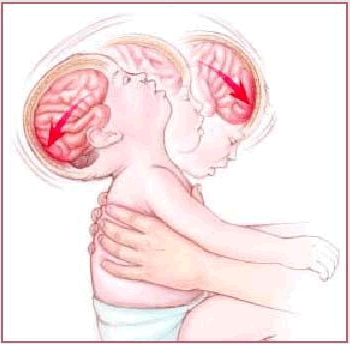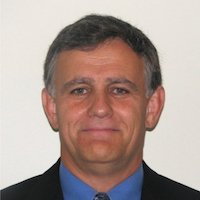 The term “shaken baby syndrome” (SBS) was developed to explain those instances in which severe intracranial trauma occurred in the absence of signs of external head trauma. SBS is the severe intentional application of violent force (shaking) in one or more episodes, resulting in intracranial injuries to the child. Physical abuse of children by shaking usually is not an isolated event. Many shaken infants show evidence of previous trauma.
The term “shaken baby syndrome” (SBS) was developed to explain those instances in which severe intracranial trauma occurred in the absence of signs of external head trauma. SBS is the severe intentional application of violent force (shaking) in one or more episodes, resulting in intracranial injuries to the child. Physical abuse of children by shaking usually is not an isolated event. Many shaken infants show evidence of previous trauma.
Frequently, the shaking has been preceded by other types of abuse.
Mechanism of Injury
The mechanism of injury in SBS is thought to result from a combination of physical factors, including the proportionately large cranial size of infants, the laxity of their neck muscles, and the vulnerability of their intracranial bridging veins, which is due to the fact that the subarachnoid space (the space between the arachnoid membrane and the pia mater, which are the inner two of the three membranes that cover the brain) are somewhat larger in infants. However, the primary factor is the proportionately large size of the adult relative to the child. Shaking by admitted assailants has produced remarkably similar injury patterns:
- The infant is held by the chest, facing the assailant, and is shaken violently back and forth.
- The shaking causes the infant’s head to whip forward and backward from the chest to the back.
- The infant’s chest is compressed, and the arms and legs move about with a whiplash action.
- At the completion of the assault, the infant may be limp and either not breathing or breathing shallowly.
- During the assault, the infant’s head may strike a solid object.
- After the shaking, the infant may be dropped, thrown, or slammed onto a solid surface.
- The last two events likely explain the many cases of blunt injury, including skull fractures, found in shaken infants. However, although blunt injury may be seen at autopsy in shaken infants, research data suggest that shaking in and of itself is often sufficient to cause serious intracranial injury or death.
National Center on Shaken Baby Syndrome
Craig’s Philosophy
www.cbsmith.ca
craig@cbsmith.ca
Prevention, education, treatment and the provision of ongoing services for victims and their families are all essential elements in dealing with child maltreatment. In addition, professionals involved with child abuse know that a proper investigation is critical. As a police officer involved for many years in child abuse cases, my job was to conduct thorough, professional, investigations that elicited all available details, with a minimum of trauma to the child victims. The intent of my training is to provide professionals with the necessary skills to carry out an effective yet compassionate, child abuse investigation.
I provide courtesy consultations to anyone who has taken my training. More in depth case consultations and opinions may be provided on a per fee basis. My primary responsibility has always been to the truth and to the best interests of child victims.
Craig B. Smith, BGS, CFCI – Qualifications
-
- Twenty-seven years experience with the Royal Canadian Mounted Police.
-
Sixteen years experience investigating sexual offences and homicides.
- Bachelor of General Studies – Criminal Justice, University of Fraser Valley (2010)
- Certified Forensic Child Interviewer (2014)
- Author of Shaken Baby Syndrome An investigator’s manual (2010)
- Revised and co-authored An Investigative Guide for Sexual Offences, Third Edition, under contract to the Royal Canadian Mounted Police (2006).
- Co-developed Manual for the Investigation of Child Sexual Abuse and For the Kids, a manual and one hour training video on proper child sexual abuse investigation procedures as part of a training package for police and social workers. Canadian Society for the Investigation of Child Abuse, (1988).
- Author of “Guidelines for Child Abuse Investigations”, National Center on Shaken Baby Syndrome, (1999).
- Expert consultant on Shaken Baby Syndrome with the National Center on Shaken Baby Syndrome (1999 – present).
- Presenter at numerous conferences and courses including
- 9th ISPCAN Asia Pacific Regional Conference on Child Abuse and Neglect, Delhi, India (2011)
- 18th Annual American Professional Society on the Abuse of Children (APSAC) Conference, New Orleans USA (2010)
- 8th ISPCAN Asia Pacific Regional Conference on Child Abuse and Neglect, Perth, Australia (2009)
- Rocky Mountain Information Network conference on Crimes Against Children, Lauglin, Nevada USA (2007)
- 10th Annual Homicide School, Nevada, USA (2006).
- 9th Annual Symposium on Child Trauma, St. Louis, USA (2006).
- Joining Together: Conducting Forensic Investigations on Behalf of the Young Abused Child, Calgary, Canada (2006).
- 14th Annual Western States Sexual Assault/Abuse Seminar, Las Vegas, USA (2005).
- Missouri Police Juvenile Officer’s Association, Annual Conference and Training Institute, Missouri, USA (2004, 2005).
- International Society for the Prevention of Child Abuse and Neglect (ISPCAN), Brisbane, Australia (2004), Denver, USA (2002).
- North American Conference on Shaken Baby Syndrome, Montreal, Canada (2004).
- Third and Fourth National Conference on Shaken Baby Syndrome, Salt Lake City, USA, (2002, 2000).
- Keynote speaker at the Symposium 2002 Teddy Bears and Flashlights: Reducing the Complexities for Children & Families, St. John’s, Canada (2002).
- Australian National Conference on Shaken Baby Syndrome, Sydney, Australia (2001).
- Keynote speaker at the Suspected Child Abuse and Neglect (SCAN) Conference in Toronto, Canada (2001).
- First and Second Canadian Conferences on Shaken Baby Syndrome, Saskatoon, Canada (2001, 1999).
-
Training Sessions provided throughout Canada, United States, Australia, India, Singapore and the Phillipines to police officers, social workers, prosecutors, victim services, school and medical personnel on Child Sexual Abuse, Shaken Baby Syndrome, Interviews and Interrogations, Adult Sexual Assault Investigations.


1 comment on “Shaken Baby Syndrome | Craig Smith”